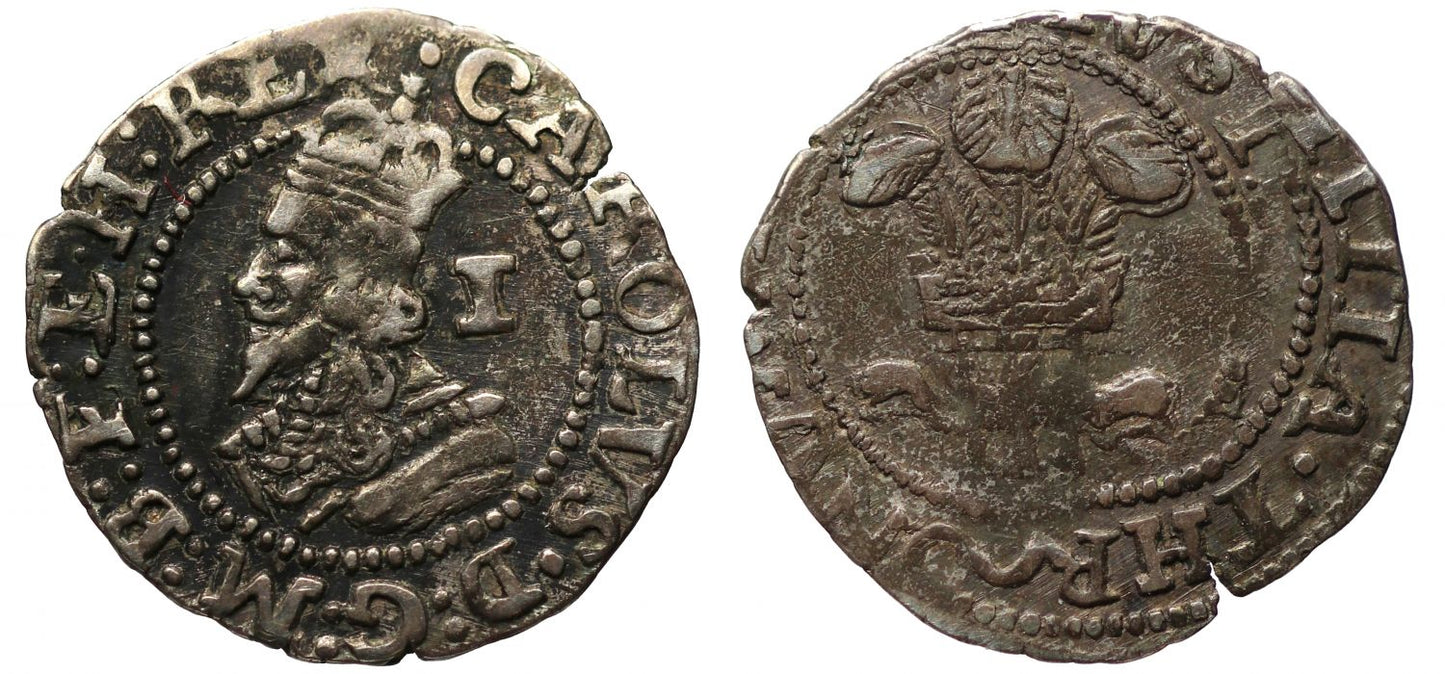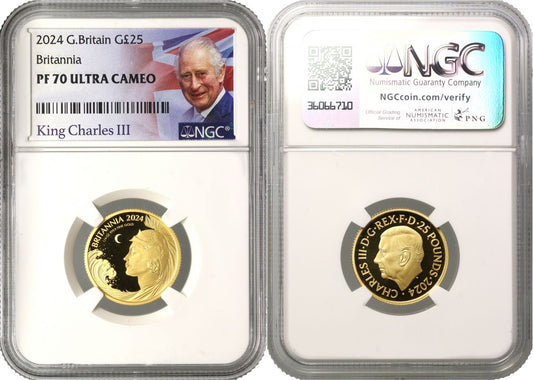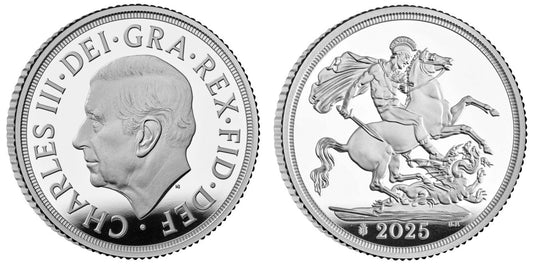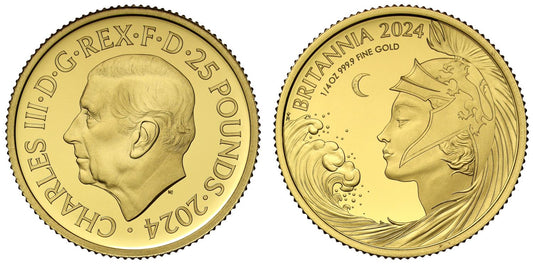FAQs
What makes a coin valuable?
I have coins to sell, what’s the next step?
How will my purchases be shipped?
What happens if I’m not entirely happy with my purchase?
Charles I Penny, Bristol Mint or late Declaration issue
Charles I (1625-49), silver Penny, Bristol Mint (1643-45), crowned bust left, value I behind, legend and beaded borders surrounding, initial mark pellet, .CAROLVS. D: G: M: B: F: E: H: REX, rev. large plumes with bands, legend and beaded borders surrounding, .IVSTITIA. THRONVM. FIRMAT, weight 0.42g (Brooker -; N.2511; S.3027). Toned and a little off-centre on reverse, a bold very fine, reverse a little weaker, extremely rare with an old provenance.
The abbreviated Latin legends translate as on the obverse, "Charles, by the grace of God, King of Great Britain, France and Ireland," and on the reverse as "Justice strengthens the throne."
The Standard Catalogue follows North in listing this variety of coin under Bristol Mint but also has a caveat that they may well be something to do with the late Declaration issues of 1645-46 after Bristol surrendered on 11th September 1645, based on the fact that the large plume punch is shared with an extremely rare late Declaration Halfgroat S.3044.
Charles was the second son of James I and Anne of Denmark born on 19th November 1600 and became the heir apparent on the death of his older brother Henry from typhoid aged 18 in 1612. James tried to unsuccessfully arrange a marriage for Charles with the Spanish, leading to Charles going to Spain in 1623 to win the Spanish Infanta Maria Anna, but was firmly rebuffed returning eight months later. King James died from dysentery on 27th March 1625 and Charles made sure he married before his coronation, to Henrietta Maria of France at first by proxy at Notre Dame on 1st May 1625, and then after they actually first met at Canterbury on 13th June. His new wife was devout catholic and refused to be involved in the protestant coronation of 2nd February 1626, but they went on to have nine children together, suffering two infant mortalities but also producing two future Kings, Charles II and James II. Charles firmly believed himself to be absolute monarch believing in the Divine Right of Kings. This often led to quarrels with his parliament resulting in Charles abolishing it in place of his personal rule, which lasted for eleven years from 1628 to 1640. This was a period seen as tyrannical with taxation over poundage and tonnage in trade, and tax known as ship money. Charles did enjoy a Scottish coronation in 1633, however, by 1640 bankruptcy was looming and Charles had £130,000 in silver bullion seized from the Mint promising to one day repay with 8% interest. The East India Company refused to make a loan with the King so their stock of pepper and spices in London was seized and sold below market value at £60,000 with a promise to refund later. Parliament was therefore called back in 1640 in the hope of raising funds, though a rebellion in Ireland broke out and a descent towards civil war began which perhaps can be best interpreted from the minting activity that occurred. Aberystwyth was the first provincial mint to open in the reign from 1638 on account of the successful mining of silver in that area by the master works of Thomas Bushell who successfully had the mint open at source to strike coins. As the situation in London declined Bushell was instructed to move the machinery from Aberystwyth to Shrewsbury where minting occurred during 1642 as the first Royalist mint, and the introduction of the largest hammered and silver coins of the English series, the Triple Unite of Three pounds in gold and the immense silver Pound. Meanwhile a mint was opened at York set up by French engraver Nicholas Briot who was highly skilled in using machinery to strike coins, as well as by hammered methods, and had recently revamped the Scottish mint in Edinburgh. Later in 1642 the King was forced to move his capital out of London to Oxford as the new Royalist stronghold, with an instruction to Bushell to bring the minting equipment to there from Shrewsbury and continue the making of the largest gold and silver, as well as everything else required to pay for wages, equipment and supplies for the Royalist army. Other Royalist mints would subsequently open at Bristol, Truro, Exeter and Worcester as well as later ones at Chester, Salopia, Ashby de la Zouch, Bridgnorth on Severn and Aberystwyth Dovey Furnace and Hartlebury Castle, as well as the Welsh Marches. As chaos reigned cities under siege also produced obsidional currency under duress at Newark, Pontefract, Carlisle and Scarborough. There were additional rebel issues and those under the Duke of Ormond in Ireland too around 1641-43. Pontefract was the last city under siege to hold out until after the eventual execution of Charles, and actually issued siege coins in the name of Charles II. As can be gauged by all this minting activity, as well as Parliamentary issues still emanating from the mint in London, armies were on the move around the country and famous battles took place like Marston Moor and Naseby with the Carolian "cavaliers" against the New Model Army of "roundheads." Charles was defeated himself by 1645 and surrendered to Scotland whereupon he was handed over to the Long Parliament but refused to bow down to the demands of a constitutional monarchy. Charles escaped in 1647 but was soon recaptured and imprisoned at Carisbrooke Castle on the Isle of Wight where he formed a secret alliance with Scotland. However, the New Model Army was all conquering leading to Charles being tried for treason and convicted and eventually beheaded around 2pm on 30th January 1649.
Major seaport the City of Bristol on the River Avon nearly 120 miles west of London grew from circa 1000 as a Saxon settlement and was an important market for slaves in the reign of Canute. Castle earthworks were constructed by Geoffrey de Coutance the Bishop of Exeter and later strengthened by Robert of Gloucester where the headquarters of the Angevin Party lay in 1140 until Robert's death in 1147. The mint was later rejuvenated with gold and silver coinage from the coinage of Edward IV and Henry VI with a stop until the reign of the Henry VIII and the corrupt mint master William Sharrington. Later it served as a Royalist mint in the time of the Civil War.
Provenance:
Ex Samuel Birchall (1761-1814), collection not sold till Dix Noonan and Webb, Auction 191, 4th May 2021, lot 126.
Ex Collection of an English Doctor part III, Sovereign Rarities fixed price list online September 2022.
FAQs
What makes a coin valuable?
I have coins to sell, what’s the next step?
How will my purchases be shipped?
What happens if I’m not entirely happy with my purchase?













